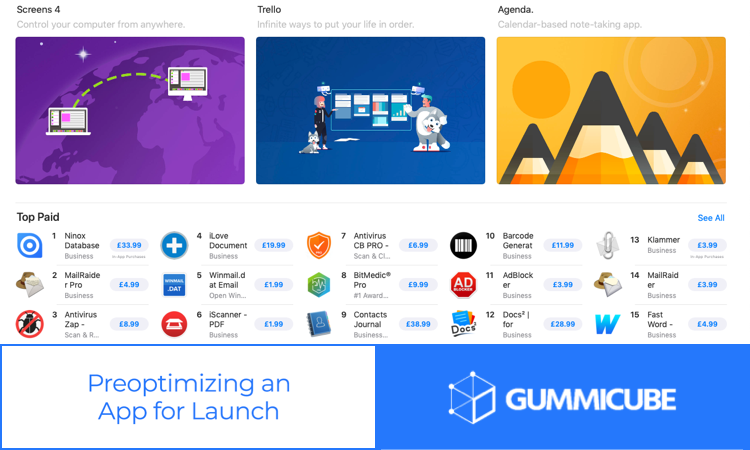We’ve partnered with Gummicube to bring you a series of blog posts covering various areas of app marketing, our first covers what you can prepare whilst your app is still in development.
So you’ve built an app, and it is nearly time to launch it. The next step will be getting the app in front of users, but you can prepare for that even before the app goes live. One of the most cost-effective and efficient methods is through App Store Optimization (ASO). ASO is the process of improving an app’s discoverability on the Apple App Store and Google Play Store, and unlike many other marketing tactics, it can be used before and after the launch. When an app is not yet live, you can prepare for a strong launch by pre-optimizing.
What is Preoptimisation?
Preoptimisation is performing the research and designing the page’s assets and metadata in preparation of a mobile application’s launch, done per ASO best practices. This includes market research into what types of apps users are searching for, what page listing setups lead to higher installs and much more.
There are several factors involved in App Store Optimisation, from the metadata behind an app to the creative sets that users see in search results and on the app’s page. If ASO is performed following best practices and utilising the right data, an app can maximise its chances of getting discovered and downloaded after launch.
How apps get discovered
When preparing an app’s page listing, you should understand how the App Store and Play Store algorithms read the metadata. The algorithms and methods to work with them will vary depending on the platform the app is on. As such, if an app is available on both iOS and Android devices, it will need a different strategy for each store.
At a high level, each platform has its own algorithm that crawls the metadata. Each one looks through the metadata and index the app for relevant search queries. Apple does this by utilizing the declared keywords in the app’s title, subtitle and keyword bank, while Google crawls the title and descriptions (short and long) to identify keywords.
For instance, a recipe app has a higher chance at appearing in search queries for terms like “recipe,” “food” and “cooking” than a VPN app would – this sounds obvious, but it is due to how the apps are set up and what the algorithms find on them. If a listing is not set up properly, then it may not show up at all.
When setting up the page listing, you need to keep relevant search queries in mind and integrate them into the metadata to build relevance. Although the recipe app may be relevant for “food” and “cooking” terms, the App Store algorithm will recognize that more quickly if it declares them in its keyword bank, while Google Play’s algorithm will index it more effectively if it sees the description talks about cooking food. It is important to consider these factors prior to launch so your listing can be optimized for indexation after deployment.
Conducting market research
Before setting up your metadata and building the creative assets, you’ll want to understand what keywords users are searching for when looking up an app like yours, as well as what creative designs convert best in your category. This will help you understand how to structure your metadata and creatives to be in-line with yet differentiated from the competition.
The best way to conduct this research is to use ASO software. This will provide you with insight into who your competitors are, what keywords are trending and more. This information can help you shape your strategy – if one keyword has a much higher volume than another, you’ll have a better idea of which one to target (although you should still ensure the term is relevant, while niche keywords with less competition are also valuable). If your competitors are utilizing creative features that appeal to users, you can try something similar.
During this process, it’s important to remember that a strategy that works for one app may not work for another – you’ll want to find takeaways that work for your app, not just picking keywords and creative elements because someone else is doing it. Researching trends and planning out creatives prior to launch is essential to convert users once the app goes live.
Once you gather your findings, you’ll want to build out the metadata and creatives while following ASO best practices.
Conclusion
Preparing for an app’s launch includes several moving pieces. Planning out the ASO strategy for your app is a key facet, as it can help your app start indexing for key terms after launch.
To maximize your chances of success, you’ll want to understand how the App Store and Play Store algorithms work, so you can optimize within them. From there, you’ll want to research your app’s market to further understand what keywords users are searching for, who your competitors are and what creative assets convert users best. Use this data to build your page listing so it can start off strong.
By taking the time to truly understand your app’s market and build a strategy tied around it, an app can put its best foot forward at launch. This will give it a good starting point from which it can grow and reach users.
Other articles in this series (coming soon):
- Using A/B Testing to Better Conversion
- Incorporating Apple Search Ads & Google UAC
